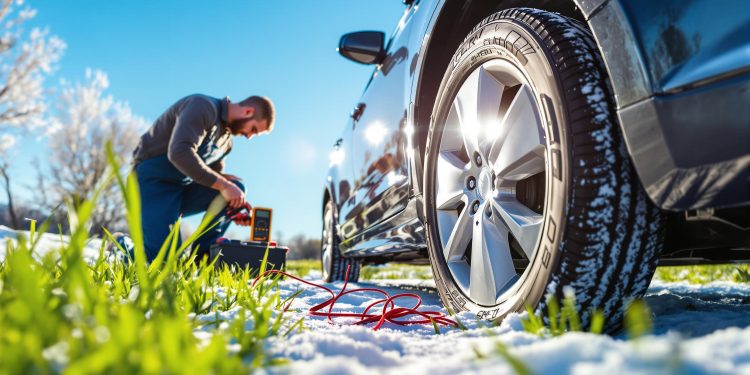Winter can be tough on your car, even in South Africa’s milder climate. Cold mornings, frost, and temperature drops can lead to battery issues, reduced tire grip, thickened engine oil, and poor visibility. To keep your car running smoothly and ensure your safety, here are 7 simple tips to prepare for winter:
- Check Your Battery: Test charge, clean terminals, and ensure it’s in good condition.
- Inspect Tire Pressure and Tread: Keep tires properly inflated and maintain a tread depth of at least 1.6mm.
- Monitor Fluids: Use winter-grade oil, check coolant levels, and add antifreeze washer fluid.
- Maintain Wipers and Lights: Replace worn wipers, clean headlight lenses, and ensure all lights work.
- Service Your Heating System: Test heat output and defrosting functions.
- Assemble a Winter Emergency Kit: Include essentials like jumper cables, blankets, and a first aid kit.
- Clean and Protect Your Car: Apply wax, treat the undercarriage, and use water-repellent treatments on windows.
Proactive care can prevent breakdowns and costly repairs. Start now to keep your car reliable and safe during the colder months.
Winter Car Maintenance Checklist
1. Check Your Car Battery
South African winters can put extra stress on car batteries because colder temperatures slow down chemical reactions. Experts caution: "Colder temperatures can reduce a battery’s efficiency and lifespan. It’s essential to check the battery’s charge and ensure the terminals are clean and free from corrosion" [5][3].
Here’s what to watch for if your battery might be failing:
- Slow engine cranking
- Dim or flickering headlights
- Trouble starting the car, especially in the morning
To keep your battery in good shape, clean off any corrosion from the terminals, make sure connections are secure, and test the charge regularly – especially if your battery is over three years old. Many workshops offer quick battery tests that can save you from unexpected breakdowns.
If your car will be parked for a long time during winter, think about using a battery maintainer. These devices help keep the charge at an ideal level, avoiding issues when you’re ready to drive again.
Remember, a battery that works fine in warm weather might fail completely in the cold, and that could lead to bigger problems with your alternator or starter system [2][3].
Next up: Why tire pressure changes matter in cold weather.
2. Inspect Tire Pressure and Tread
Once your battery is in good shape, it’s time to focus on tire health. Tires are your vehicle’s connection to the road, and keeping them in top condition is crucial, especially during winter. Proper inflation and sufficient tread help you stay safe on slippery, wet surfaces.
"Tyre pressure can drop with the temperature, leading to under-inflated tyres, which can affect fuel efficiency and handling" [3]
Cold weather causes tire pressure to drop, so regular checks are a must. To maintain performance, consider increasing the pressure by 0.2-0.3 bar above the manufacturer’s recommendation [6]. Here’s a simple maintenance routine:
- Check tire pressure every two weeks (when tires are cold)
- Measure tread depth monthly
- Inspect tires thoroughly before long trips
Tread Depth Rules
Your tire tread depth must not be less than 1.6mm, as required by law in South Africa [4]. Worn-down treads reduce grip, especially on wet winter roads. Use a tread depth gauge to measure, paying close attention to the outer edges where wear is often more pronounced.
Once your tires are ready for winter, the next step is keeping an eye on your vehicle’s vital fluids.
3. Monitor Car Fluids
After preparing your tires and battery, it’s time to focus on the essential fluids that keep your car running smoothly – especially during the colder months.
Cold weather doesn’t just affect your battery and tire pressure; it also thickens your engine oil. As Vishal Premlall, National Director of the Tyre Equipment Parts Association (TEPA), points out:
"Colder temperatures can make oil thicker, which will affect its lubrication properties within the engine. Thick oil means a slower-running engine." [3]
Make it a habit to check your oil level every two weeks. Pay attention to its texture and color – if it feels unusually thick or looks darker than usual, it’s time for a change. Switching to a winter-grade oil can help ensure it flows properly in the cold [1].
Your cooling system also needs extra care in winter. A proper antifreeze-to-water ratio is key to preventing the coolant from freezing and keeping your engine at the right temperature. Here are some important checks to prioritize:
| Check | How Often | What to Watch For |
|---|---|---|
| Coolant Level | Every 2 weeks | Low levels, sweet smells, or fluctuating temperature readings |
| Antifreeze Concentration | Monthly | Discoloration or rust particles in the fluid |
| Leaks | Weekly | Puddles under the car or white smoke from the exhaust |
Don’t forget about your windshield washer fluid. It’s essential for clear visibility on frosty mornings. Opt for a washer fluid with antifreeze properties to avoid freezing in the reservoir or lines [7].
Once your fluids are in check, the next step is making sure your wipers and lights are ready for winter challenges.
sbb-itb-09752ea
4. Maintain Wipers and Lights
Once your fluids are sorted, it’s time to focus on your car’s visibility systems – especially important during winter’s shorter days and wet conditions. Just like antifreeze keeps your engine safe, using the right washer fluid ensures it won’t freeze and keeps your windshield clear.
Clear visibility is key for safe winter driving in South Africa. With less daylight and more rain, mist, and fog, having well-maintained wipers and lights is a must.
Here’s a quick guide to winter visibility checks:
| Component | How Often to Check | What to Check For |
|---|---|---|
| Wiper Blades | Monthly | Cracks, wear, or dull edges |
| Headlight Lenses | Weekly | Fogging, scratches, or yellowing |
| Fog Lights | Monthly | Dirt buildup, proper alignment |
| Light Bulbs | Weekly | Burnt-out bulbs or dim performance |
For headlights, clean the lenses weekly to remove dirt and oxidation. If they’ve turned yellow, use a polishing kit to restore them [2].
Fog lights need monthly attention too – clean them and check their alignment. Their low beam pattern is designed to cut through mist more effectively than high beams [2].
5. Service Your Heating System
Once your visibility systems are in order, it’s time to focus on your car’s heating system. In South African winters, a properly working heating system isn’t just about staying warm – it’s also crucial for keeping your windows clear, which helps prevent accidents [4].
Even though South Africa’s winters aren’t as harsh as those in the northern hemisphere, cities like Johannesburg can experience chilly early mornings. This makes a reliable heating system an absolute must.
Key Components to Inspect
Here are the main parts of your heating system that should be checked by a professional:
| Component | Function | What to Inspect For |
|---|---|---|
| Heater Core | Provides warm air | Ensure proper heat output and even distribution |
| Thermostat | Manages temperature | Check for consistent temperature regulation |
| Defrosting System | Clears windshield fog | Confirm even airflow across the windshield |
Vishal Premlall, National Director of the Tyre Equipment Parts Association (TEPA), emphasizes:
"A well-functioning heating and defrosting system is not just about comfort; it’s a safety necessity" [3].
Essential Heating System Checks
Before winter arrives, take these steps to ensure your heating system is in top condition:
- Test Heat Output: Run the system at full power to confirm it heats up quickly and maintains a steady temperature.
- Check Defrosting Function: Make sure all vents are working and effectively clearing fogged windows.
- Monitor Antifreeze Levels: Keep the antifreeze concentration at the correct level to avoid freezing issues.
If you experience uneven heating, weak airflow, or windows that take too long to defog, get your system inspected by a professional immediately [3].
6. Assemble a Winter Emergency Kit
Once your heating system is ready, it’s time to prepare for unforeseen winter challenges. A well-stocked emergency kit can help you handle tricky situations on the road.
Key Items for Your Kit
Here’s what you’ll need to stay safe and prepared:
| Category | Items | Why You Need Them |
|---|---|---|
| Safety Equipment | First aid kit, reflective triangles, flashlight (with extra batteries) | For visibility and basic emergency response |
| Vehicle Recovery | Jumper cables, basic toolkit, spare tire with tools | To manage roadside breakdowns |
| Personal Comfort | Warm blankets | To stay warm during delays |
| Communication | Emergency phone charger, updated contact list | To stay connected in emergencies |
Tips for Storing Your Kit
Keep everything organized in waterproof, labeled containers. Place them somewhere accessible, like your trunk. According to the Tyre Equipment Parts Association (TEPA), grouping items by how often you use them can save time during an emergency.
Routine Checks
Inspect your kit every three months to ensure everything is in working order:
- Replace expired first aid items.
- Test and replace flashlight batteries if needed.
- Rotate food and water supplies.
- Update your emergency contact list.
"A well-maintained emergency kit can mean the difference between a minor inconvenience and a major crisis during winter driving conditions", says SANRAL [4].
Tailor Your Kit to Your Region
Adjust your kit based on where you live or travel:
- High-altitude areas: Add an emergency blanket and insulated gloves.
- Coastal regions: Include a waterproof poncho and extra windscreen washer fluid.
- Rural areas: Pack a basic GPS device for navigation.
Once your emergency kit is ready, you can shift your focus to protecting your car from winter weather.
7. Clean and Protect Your Car
Once you’ve prepared for emergencies, it’s time to focus on shielding your car from winter’s harsh effects. In South Africa, winter conditions can speed up corrosion and damage, impacting both the exterior and interior of your vehicle. Taking preventive steps helps keep your car safe and reliable.
How to Protect Your Car’s Exterior
Your car’s exterior is the first line of defense against winter weather. To minimize damage:
- Apply winter-grade wax every three months to shield the paint.
- Treat the undercarriage with a rust inhibitor to prevent corrosion.
- Use water-repellent treatments on windows monthly for better visibility.
- Spray exposed metal parts every two months to stop rust from forming.
Tips for Interior Maintenance
Moisture can wreak havoc on your car’s interior, leading to mold and bad smells. To combat this, use a small dehumidifier whenever your car is parked. This simple step can help keep the interior dry and fresh.
Professional Maintenance Recommendations
The Tyre Equipment Parts Association (TEPA) advises the following routine checks:
- Inspect for rust monthly, especially in vulnerable areas.
- Schedule professional inspections every three months to catch issues early.
- Repair paint damage immediately to prevent further problems.
Parking also plays a key role in protecting your car. If you have no choice but to park outside, invest in a durable car cover suited to South Africa’s weather.
"Regular cleaning and protection during winter months can extend your vehicle’s lifespan by preventing rust and preserving its resale value. It’s not just about aesthetics – it’s about maintaining your car’s structural integrity", says ImotoNews South Africa’s automotive maintenance expert [1].
Conclusion
By following these seven tips, South African drivers can reduce the risk of cold-weather breakdowns and stay safer on the roads. As TEPA highlights:
"Regular battery checks and proper tire maintenance are fundamental aspects of winter car care that can prevent most common cold-weather issues" [3]
Key maintenance steps include:
- Testing your battery regularly
- Checking tire pressure monthly
- Monitoring fluid levels on schedule
- Getting professional inspections
- Ensuring wipers and lights are working
- Maintaining the heating system
- Keeping an emergency kit handy
- Applying rust prevention treatments
These actions not only prevent expensive repairs but also ensure your car performs reliably during the colder months. ImotoNews South Africa underscores the importance of preparation:
"Proactive winter maintenance protects both road safety and vehicle value", notes ImotoNews South Africa [1]
Take these steps before winter sets in to keep your vehicle running smoothly when the temperatures drop.
Related Blog Posts
- Factors That Influence Used Car Prices in South Africa
- Fuel-Saving Tips for Long South African Road Trips
- Top 5 Cars for South African Roads
- 10 Tips to Avoid Car Scams in South Africa





